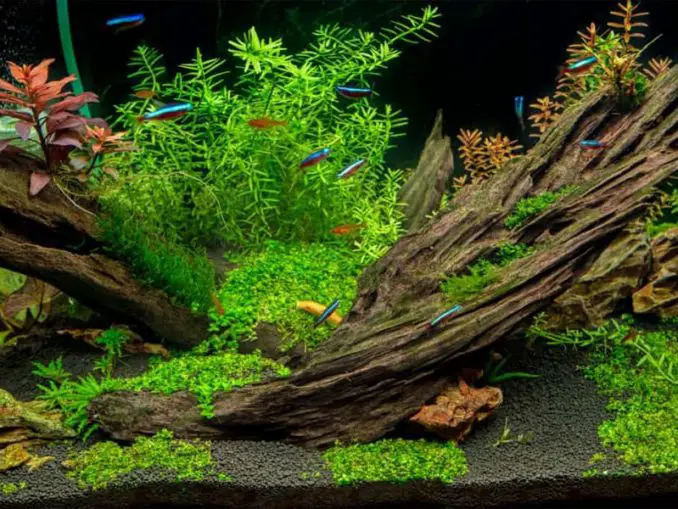Driftwood And Rock Aquarium
Do you want to create a stunning and natural-looking aquarium in your home or office? If so, then you might want to consider adding driftwood and rock as decorative elements. These materials can add beauty, texture, and dimension to your aquarium, making it a more enjoyable environment for your fish and other aquatic pets. In this post, we will explore the benefits of using driftwood and rock in your aquarium, as well as some tips for selecting and decorating with these materials.
Pain Points of Aquariums
Creating and maintaining an aquarium can be a challenging task for beginners and experienced enthusiasts alike. One common pain point is achieving a natural-looking environment that also meets the needs of your fish. Without careful selection and placement of decor, a tank can appear artificial and unappealing. Using driftwood and rock is an effective way to help create a more realistic environment that is also functional for your fish and plants.
Target of Using Driftwood and Rock in Aquariums
The primary target of using driftwood and rock in aquariums is to create a more natural habitat for the fish and aquatic pets. These materials provide shelter, hiding spots, and a natural barrier that aids in controlling water flow. They can also create a dynamic and interesting visual effect that enhances the overall beauty and appeal of the aquarium.
Summary of Main Points
Using driftwood and rock in your aquarium can add visual appeal and functionality to the environment. They provide shelter, hiding spots, and natural barriers to control water flow. When selecting driftwood and rock, consider the size, texture, and weight of the materials, as well as their impact on water chemistry and filtration. Proper placement and arrangement can create a more balanced and harmonious environment that is enjoyable for your aquatic pets and visually stunning for you and your guests.
Using Driftwood in Aquariums
Driftwood is a popular and versatile decor option for aquariums. It can be used in many different ways, including as a centerpiece or as a backdrop for plants and other decor. When selecting driftwood, consider its size, texture, and weight, as well as its impact on water chemistry and filtration. It is important to properly clean and treat the driftwood before adding it to your tank to prevent harmful bacteria or excess tannins.

One of my favorite ways to use driftwood in an aquarium is to create a natural-looking cave or tunnel formation that provides a hiding spot for fish or other pets. I also like to incorporate live plants around the driftwood to create a lush and vibrant environment.
Using Rock in Aquariums
Rock is another common and attractive decor option for aquariums. It can be used to create rock formations, caves, and ledges that provide shelter and hiding spots for fish and other aquatic pets. When selecting rocks for your aquarium, consider their size, texture, and weight, as well as their impact on water chemistry and filtration. It is important to properly clean and treat the rocks before adding them to your tank to prevent harmful bacteria or chemicals.

One of the benefits of using rock in an aquarium is that it can create a more natural-looking environment. I like to use rock to create a flowing river or waterfall effect, with water cascading down from a higher rock formation to a lower one. This creates a sense of movement and energy in the aquarium that is visually appealing and interesting for the fish to explore and interact with.
Tips for Decorating with Driftwood and Rock in Aquariums
When decorating with driftwood and rock in your aquarium, it is important to consider the overall size and shape of the tank, as well as the needs and habits of the fish and other aquatic pets. Top tips for decorating include:
- Use a combination of large and small pieces to create a more natural-looking environment
- Place heavier items at the bottom of the tank to prevent them from shifting or collapsing on top of the fish
- Arrange the decor to create distinct zones or areas in the tank, such as a plant area or a hiding spot for fish
- Use natural materials that are safe for your fish and will not affect the water chemistry or filtration
- Monitor the decor regularly to ensure that it is not causing any problems, such as blocked filters or too much debris buildup
Question and Answer
1. How can I tell if the driftwood or rock is safe for my fish?
You can test the driftwood or rock by soaking it in water for a few weeks and monitoring the pH levels. If there are any significant changes in the pH levels, then the material may not be suitable for your aquarium. You can also research the specific type of driftwood or rock to see if it has been known to cause any harm or affect water chemistry.
2. How much driftwood or rock should I add to my aquarium?
The amount of driftwood or rock you add to your aquarium depends on the size and shape of the tank, as well as the needs and habits of the fish. As a general rule, you should aim to strike a balance between having enough decor to create a natural-looking environment and not overcrowding the tank or making it difficult for the fish to swim freely.
3. Can I use any type of rock or driftwood for my aquarium?
No, not all types of rock or driftwood are suitable for aquariums. Some may contain harmful chemicals or bacteria, while others may affect water chemistry or filtration. It is important to research the specific type of decor you plan to use and test it before adding it to your tank.
4. How often should I clean and rearrange the decor in my aquarium?
You should clean and rearrange the decor in your aquarium on a regular basis, at least once a month or as needed. This helps to prevent buildup of debris and harmful bacteria, and also keeps the environment fresh and stimulating for your fish. It is important to monitor the decor regularly and remove any items that are causing problems, such as blocking filters or creating too much turbulence in the water.
Conclusion
Driftwood and rock are effective and attractive decor options for aquariums. They create a more natural-looking environment that enhances the beauty and functionality of the tank. When selecting and arranging these materials, it is important to consider the needs of your fish and other aquatic pets, as well as the impact on water chemistry and filtration. With proper care and attention, driftwood and rock can transform your aquarium into a stunning and enjoyable environment for both you and your aquatic pets.
Gallery
Stunning Driftwood In Open Top Aquarium With Rocks, Live Plants, & Sand

Photo Credit by: bing.com / sand aquascape planted substrate
Driftwood In Aquariums - What You Should Know | Felix Smart

Photo Credit by: bing.com / driftwood aquariums
Aquarium Driftwood | Aquarium Accessories, Driftwood Decor, Aquarium

Photo Credit by: bing.com / aquarium driftwood aquariumfishs thebestdriftwood
How To Make Driftwood For Your Aquarium

Photo Credit by: bing.com / driftwood bodengrund prepare dunkler fishkeepingworld itsafishthing sheng
My Driftwood Cave Tank On FTS Friday: Six Months In. (x-post From /r

Photo Credit by: bing.com / fts aquariums plantedtank